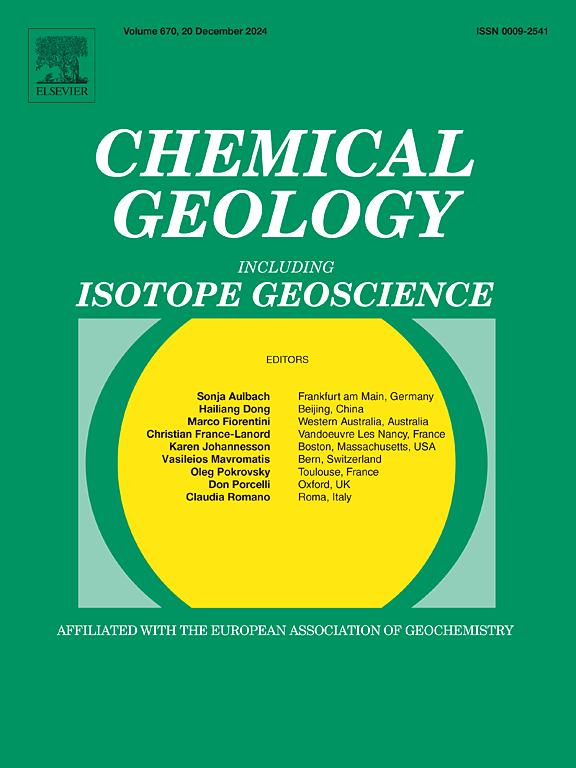Trace element partitioning coefficients between orthopyroxene and melt: Parameterizations of D variations and an improved Lattice Strain Model for rare Earth elements
IF 3.6
2区 地球科学
Q1 GEOCHEMISTRY & GEOPHYSICS
引用次数: 0
Abstract
Nernst partition coefficient data (D) between orthopyroxenes with <5.5 mol% Wollastonite component and melts are compiled and interpreted to generate simple linear equations allowing orthopyroxene/meltD values to be calculated for 48 trace elements. The regression coefficients apply to melts ranging in composition from carbonatite to granite, and use commonly measured and petrologically significant variables as inputs. 2561 crystal/liquid pairs yielding 8219 individual D measurements were considered. Results from extra-terrestrial melts and synthetic (non-natural) melts often yield trends distinct from those of terrestrial melts, and were excluded from many regressions so as to tailor the parameterizations to terrestrial melts. With few exceptions orthopyroxene/meltD increases with decreasing temperature, orthopyroxene molar mg/(mg + fetotal), weight % melt MgO and MgO/(MgO + FeO⁎); and with increasing wt% melt SiO2 and Na2O + K2O contents. No strong correlations of D with melt water content were observed. Changes in oxygen fugacity affect partitioning of V, Mo, W, Re, and to a lesser extent Eu, and several of these regressions can be used as oxygen barometers. orthopyroxene/meltDREE yield well-constrained linear functions for ratios of LnD (e.g. LnDLa/LnDCe) of elements with similar ionic radii. Model Nearest-Neighbour orthopyroxene/meltDREE profiles (NN-DREE) were constructed from these LnD/LnD ratios from a starting point at DYb. As DYb increases, the LREE-depleted NN-DREE model profiles rise and flatten. Model NN-DREE profiles computed at a given melt MgO or SiO2 content resemble published partitioning data for chemically comparable melts. A series of model NN-DREE profiles for a wide range of corresponding melt MgO and SiO2 were fit with a Lattice Strain Model (LSM) to constrain variations of D3+0 (the strain compensated partition coefficient), r3+0 (the strain-free radius of the site into which REE substitute), and E3+M (the elastic response of the M-site hosting REE as measured by Young's Modulus). Excellent LSM fits were obtained assuming a constant value of r3+0 = 0.81 Å. Regression of experimental temperature against wt% melt LnMgO applied to the global data set was used to parameterize an internal temperature-composition function, required for application of the LSM. Values of r3+0, D3+0 and E3+M derived from the LSM fits against multiple NN-DREE profiles at diverse melt MgO and SiO2 contents were regressed against melt MgO or SiO2 to parameterize a NN-DREE-LSM. This allows the complete orthopyroxene/meltDREE profile to be calculated for any magma as long as DYb can be constrained. Here, model LnDYb values were calculated from regressions against melt and mineral compositions. The NN-DREE-LSM parameterized against melt MgO content yields model DYb = 0.054 and DLa = 0.0009 (DYb/DLa = 59.2) for ultramafic melts with MgO = 25 wt%. As MgO decreases, model DREE values rise and the NN-DREE profiles flatten. By ∼0.5 % MgO (rhyolitic melts) DYb becomes compatible. The highest model DYb = 4.21 and DLa = 0.100 (DYb/DLa = 42) correspond to hyper-siliceous (SiO2 > 80 %) melts with ∼0.1 % MgO. Trace element contents of melts in equilibrium with an orthopyroxene-rich cumulate from the Bay of Islands ophiolite were calculated as an example, yielding a trace element profile closely resembling boninitic melts. For carbonatite-kimberlite melts (SiO2 < 30 %), NN-DREE profiles were parameterized as a function of melt SiO2. The lowest model DYb = 0.0023 and DLa = 0.000021 (DYb/DLa = 108) correspond to near-pure carbonatite (1 % SiO2). As melts become kimberlitic (SiO2 > 15 %) the model DREE profiles rise and come to resemble magnesian silicate melt DREE profiles.
正辉石和熔体之间的微量元素分配系数:D变化的参数化和稀土元素改进的晶格应变模型
对含有<;5.5 mol%硅灰石成分的正辉石和熔体之间的能量分配系数数据(D)进行编译和解释,生成简单的线性方程,从而计算出48种微量元素的正辉石/meltD值。回归系数适用于从碳酸盐岩到花岗岩组成的熔体,并使用通常测量的和岩石学上重要的变量作为输入。2561个晶体/液体对产生8219个单独的D测量。地外熔体和人工(非自然)熔体的结果往往产生与地球熔体不同的趋势,并且被排除在许多回归中,以便使参数化适应地球熔体。除少数例外,正辉石/meltD随温度降低而升高,正辉石摩尔浓度mg/(mg + fetotal)、重量%熔体MgO和MgO/(MgO + FeO);随着熔体SiO2和Na2O + K2O含量wt%的增加。D与熔体含水量没有很强的相关性。氧逸度的变化影响V、Mo、W、Re的分配,并在较小程度上影响Eu的分配,其中一些回归可以用作氧晴雨表。对于具有相似离子半径的元素的LnD比率(例如LnDLa/LnDCe),正晶硅/熔融稀土可以得到约束良好的线性函数。以DYb为起点,利用这些LnD/LnD比值构建了模型最近邻正硅石/熔融稀土剖面(nn - ree)。随着DYb的增加,lree枯竭的nn - ree模式剖面上升并趋于平缓。在给定熔体MgO或SiO2含量下计算的模型NN-DREE剖面类似于化学上可比较的熔体的已公布的分配数据。采用晶格应变模型(LSM)拟合了相应熔体MgO和SiO2的一系列模型nn - REE曲线,以约束D3+0(应变补偿分配系数)、r3+0 (REE替代位点的无应变半径)和E3+M(杨氏模量测量的M位点承载REE的弹性响应)的变化。假设常数为r3+0 = 0.81 Å,得到了很好的LSM拟合。将实验温度与应用于全局数据集的熔体LnMgO的wt%进行回归,以参数化LSM应用所需的内部温度组成函数。在不同熔体MgO和SiO2含量下,LSM拟合得到的r3+0、D3+0和E3+M值与熔体MgO或SiO2进行回归,以参数化NN-DREE-LSM。这样,只要DYb可以约束,就可以计算出任何岩浆的完整正辉石/熔融ree剖面。在这里,模型LnDYb值是根据熔体和矿物成分的回归计算的。以MgO含量为参数的NN-DREE-LSM模型对MgO = 25 wt%的超镁熔体的DYb = 0.054, DLa = 0.0009 (DYb/DLa = 59.2)。随着MgO的降低,模型ree值升高,nn - ree剖面趋于平缓。到~ 0.5% MgO(流纹岩熔融)时,DYb变得相容。最高模型DYb = 4.21, DLa = 0.100 (DYb/DLa = 42)对应高硅(SiO2 >;80%)与~ 0.1%的MgO熔体。以岛湾蛇绿岩中富正辉石堆积平衡熔体的微量元素含量为例进行了计算,得到的微量元素分布图与渤美质熔体非常相似。对于碳酸盐-金伯利岩熔体(SiO2 <;30%), nn - ree曲线参数化为熔体SiO2的函数。最低模型DYb = 0.0023, DLa = 0.000021 (DYb/DLa = 108)对应近纯碳酸盐岩(1% SiO2)。当熔体变成金伯利岩(SiO2 >;15%),模型DREE曲线上升,接近镁硅酸盐熔体DREE曲线。
本文章由计算机程序翻译,如有差异,请以英文原文为准。
求助全文
约1分钟内获得全文
求助全文
来源期刊

Chemical Geology
地学-地球化学与地球物理
CiteScore
7.20
自引率
10.30%
发文量
374
审稿时长
3.6 months
期刊介绍:
Chemical Geology is an international journal that publishes original research papers on isotopic and elemental geochemistry, geochronology and cosmochemistry.
The Journal focuses on chemical processes in igneous, metamorphic, and sedimentary petrology, low- and high-temperature aqueous solutions, biogeochemistry, the environment and cosmochemistry.
Papers that are field, experimentally, or computationally based are appropriate if they are of broad international interest. The Journal generally does not publish papers that are primarily of regional or local interest, or which are primarily focused on remediation and applied geochemistry.
The Journal also welcomes innovative papers dealing with significant analytical advances that are of wide interest in the community and extend significantly beyond the scope of what would be included in the methods section of a standard research paper.
 求助内容:
求助内容: 应助结果提醒方式:
应助结果提醒方式:


